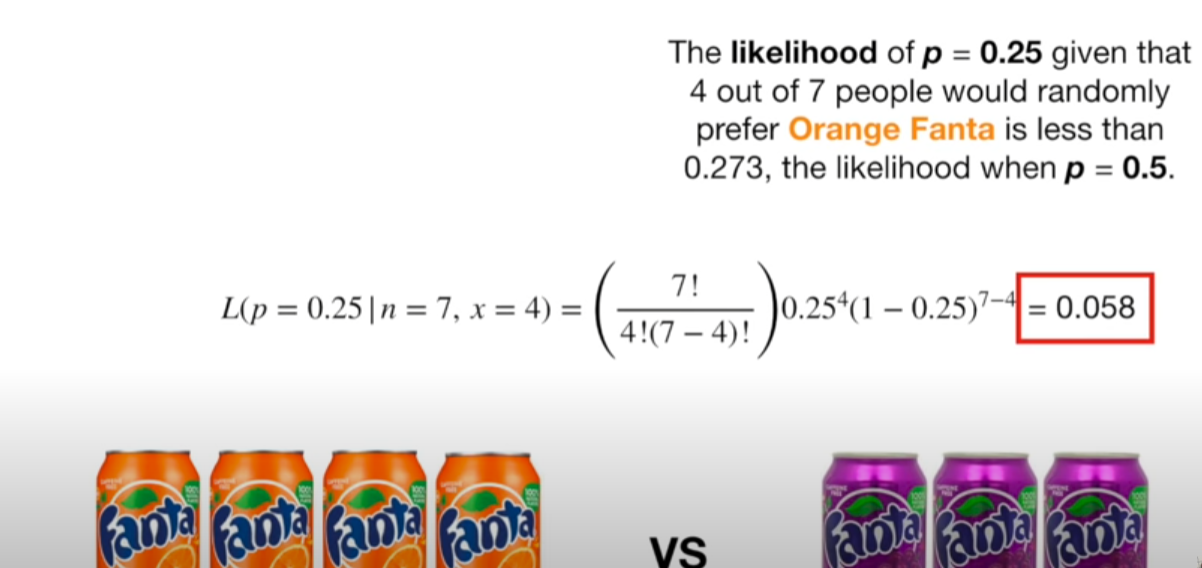The likelihood function $L(p; n, x)$ is $L(p; n, x) = \binom{n}{x} p^x(1-p)^{n-x}$ which, regarded as a function of $p$, has value $0.058$ when $n$ and $x$ happen to equal $7$ and $4$ respectively, that is, $L(0.25 \mid 7, 4) = 0.058$ as claimed in the picture you have included. The statement that puzzles you is not what you quote from the picture: it is a mangling of what is actually said in the picture, viz.,
"is less than $0.273$, the likelihood when $p=0.5$."
What the statement is claiming is that $L(0.25; 7, 4) = 0.058$ is a smaller number than $L(0.5; 7, 4) = 0.273$ which everyone will agree with, I hope. It does not say "a likelihood of $p=0.25$ when $p=0.5$" as you think it does.
In short, inferring (and claiming in print advertisements and TV commercials) that $3$ of $4$ dentists recommend Grape Fanta over Orange Fanta when recommending a Fanta flavor to their patients who drink Fanta when the evidence is that $4$ out of $7$ dentists actually surveyed chose Orange Fanta over Grape Fanta is a serious mis-representation of the data and likely to bring condemnation from the readers of stats.SE and maybe even the Advertising Council and the FTC. As the picture says, claiming that dentists are actually equally divided between Orange and Grade Fanta is better since $L(0.5) > L(0.25)$.
Exercise: Show that $L(p; 7,4)$, regarded as a function of $p \in [0,1]$, attains maximum value at $p = \frac 47 = 0.571428\ldots$
Turning to "Likelihood describes the joint probability of the observed data as a function of the parameters of the chosen statistical model"
the joint probability here is the probability that $4$ of the $7$ dentists preferred Orange Fanta while the other three preferred Grape Fanta. This joint probability is the sum of the probabilities of the $35 = \binom{7}{4}$ vectors of $7$ possible answers ($7$-tuples if you prefer that name over vectors) that might be obtained when $4$ out of $7$ dentists say that they prefer Orange Fanta over Grape Fanta and $3$ have the opposite preference. The possible vectors of $7$ answers are
\begin{align}
&(O,O,O,O, G, G, G)\\
&(O,O,O,G, O, G, G)\\
&(O,O,O,G, G, O, G)\\
&(O,O,O,G, G, G, O)\\
&(O,O,G,O, O, G, G)\\
&(O,O,G,O, G, O, G)\\
&(O,O,G,O, G, G, O)\\
&\text{and so on till the $35$-th item}\\
&(G,G,G, O, O, O, O)
\end{align}
Each vector has probability $p^4(1-p)^3$ (hidden assumption: the dentist preferences are independent and each dentist has probability $p$ of preferring Orange Fanta over Grape Fanta) giving that the _joint probability that $4$ of $7$ dentists prefer Orange Fanta over Grape Fanta is $\binom{7}{4}p^4(1-p)^3 = 35p^4(1-p)^3$. How come we can just add up these $35$ probabilities? Well, if one specific vector of answers is observed, we are automatically excluding all other $34$ vectors of answers as possible: these are disjoint (a.k.a. mutually exclusive) events and so the probability that some one of these $35$ vectors (we don't care which one) was observed (i.e. some $4$ out of the $7$ dentists asked preferred Orange Fanta over Grape Fanta) is $\binom{7}{4}p^4(1-p)^3 = 35p^4(1-p)^3$. For each $p \in [0,1]$, the likelihood function (regarded as a function of $p$, with $n$ and $x$ as parameters), has value equal to the joint probability of the observations given the parameters. Thus, $L(p; 7, 4) = \binom{7}{4}p^4(1-p)^3$.

